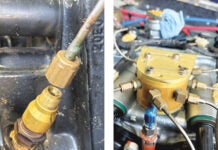In a distant land, from which Vikings sailed and some of my forefathers sprang, three aircraft owners gathered and stared at a broken bolt and a landing gear leg twisted in its mount. This was the third time, they reported, in four weeks that a landing gear bolt broke on one of their three tailwheel-configured Sonex aircraft. As I read the report, my eyebrows pinched together. Clearly this was a serious situation, but how could three (100%) of the aircraft at a single airport have a problem that fleet-wide—worldwide—had come up less often than Adam Sandler’s name at the Grammy Awards? They concluded the bolt was undersized and needed to be beefed up. I concluded more information was needed on each incident, each aircraft, and the airstrip.

Their grass airstrip was described as “not fairway smooth” but used routinely by Cessnas, Pipers, and the like. That should pose no problem for a tailwheel Sonex. The pilots seemed well qualified; all were instructor-rated but flying their aircraft only for pleasure. The aircraft themselves were a mixed bag of hours and histories that broke down like this:
• Aircraft #1 was purchased as a completed aircraft and imported to the country before it had flown. Upon arrival, the landing gear bolts were replaced (no reason was given for this), and the aircraft was flown only 25 hours before it experienced a bolt failure.
• Aircraft #2 was also a completed aircraft imported to the country. It had approximately 230 hours at the time of import, and its previous owner reported no bolt failures. It experienced a bolt failure after approximately 30 flying hours in its new country.
• Aircraft #3 was built by the reporting individual. It had had two bolt failures, the right side at 210 flying hours (at which time both bolts were replaced) and the left side after an additional 120 flying hours.
The reporting individual added, “The local airforce [sic] maintenance facility…inform [sic] it is a classical [sic] fatigue failure caused by excessive shear.” An accompanying photo showed a bolt that had failed in shear. One of the broken bolts was measured and no stretching was detected. The group proposed various fixes including a stronger bolt, a thicker bolt, an additional bolt, or a combination of all three: the classic “beef it up” approach. Engineering calculations, however, didn’t support the need for a change. Nor did the history of the worldwide fleet. Something was rotten in Denmark, or a country near there.
In a previous KITPLANES article, “Misplaced Confidence” (November 2017), I touched on how construction errors can spread among builders. That seemed unlikely in this case as all three airframes had varied pasts and no known modifications. The possibility of one failure from poor workmanship is always present, but the possibility that three builders made errors and all three airplanes ended up on the same field, overseas, was beyond the calculable odds. Two of the aircraft had bolt failures with fewer than 30 hours in service with their new owners. If it were a design issue, that failure rate would have shown itself fleet-wide years earlier. My own Sonex was approaching 500 hours with the original bolts. I was vested in determining a cause not only because I’m tasked with supporting the products and customers of Sonex Aircraft, but because I routinely took friends and family flying in my Sonex, often sometimes rarely drop-testing the landing gear. The affected owners approached the problem from a 100% failure rate. I approached the problem from a less than 1% failure rate. But we all wanted the same thing—resolution. If a plausible answer could be found, changes could be implemented. If one could not be found, Plan B would be “beef it up.”
Beyond their landing gear configuration, all three aircraft shared two other things: the same grass strip in Scandinavia, and three owners collaborating on a problem. Remember how Aircraft #1 had its landing gear bolts replaced by the new owner before he ever flew it? That seemed important. Maybe, after the first bolt failed, the other owners checked their bolts and tightened each nut “just a little more, to be sure.” And what if they did that again after the second failure? The increasing tension on the bolts would weaken their shear strength and set up the next failure. Combine a weakened bolt with a roughish field, and you have a plausible cause.
Sonex Aircraft issued a service bulletin for the landing gear bolt installation on all Sonex aircraft, but it may not be what you’d expect. The service bulletin changed the bolt installation from a -4 bolt retained by an elastic stop nut to a -4 drilled bolt retained by a castle nut and cotter pin. The change was an attempt to communicate to builders and subsequent owners that the nut is not meant to forcefully clamp parts together; it is meant to hold the bolt in place. Frankly, the original fasteners are still acceptable if a builder can resist the urge to “really tighten it down.” It has been seven years since the reported failures and the issuance of the service bulletin. My friends in the land of fjords have been quiet, so I must assume their string of broken bolts has ended. Reports of broken gear bolts, overall, remain a rarity.
I understand why those three owners concluded the bolts were not up to the task. It was an easy conclusion to reach based on their observations and failure rate, but the odds did not support it as a reasonable cause. Television detective shows have taught us that if you get three or more (painfully attractive) detectives together for a rapid-fire conversation, a tidy answer to a mystery will emerge in short order. The real world doesn’t always have a quick, tidy answer. The best we can do is balance all knowable facts against the odds.













